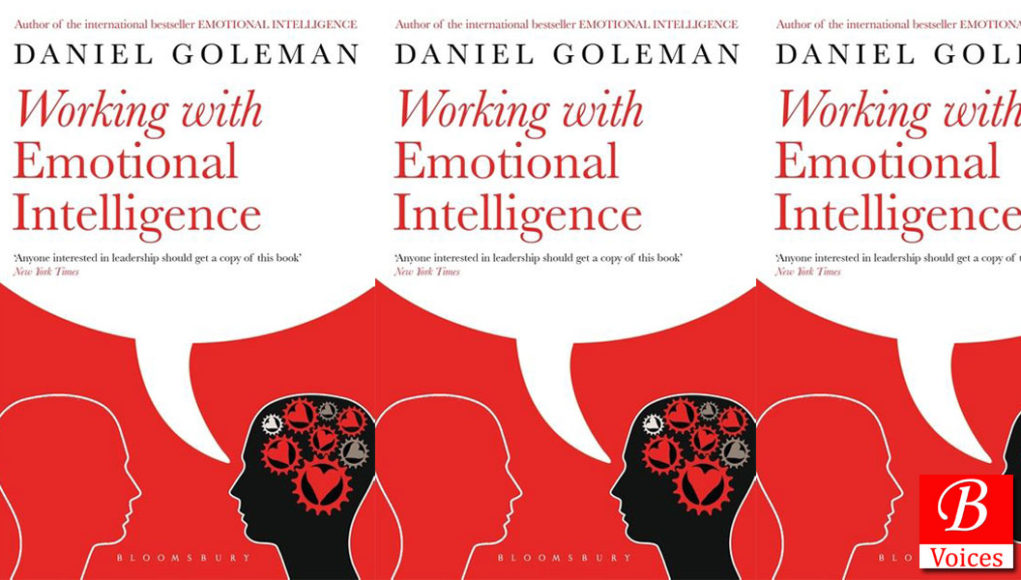Rehmat Ullah
Siimon Reynolds, self-help guru, argues that one significant reason which leads to failure of a person is lack of emotional intelligence-EQ or being emotionally incompetent. If you wish to pursue in building a successful career in leadership position in any field as doctor, engineer, academician, manager, businessman, artist or civil service, you must demonstrate emotional competency. Today, mastery over art of EQ and exhibiting emotional smartness determines your success as well as organizational thrive. While lacking this art becomes driving force behind failure in one’s life.
Given this success and failure backdrop in one’s life and learning to gain perfection in the art of EQ, Daniel Goleman’s book, Working with Emotional Intelligence, is the best guide. Quoting New York Time’s review on the title, “Anyone interested in leadership should get a copy of this book”, caught my attention to read it.
The book comprises five chapters consisting of several sub-headings explaining different aspects of EQ quoting practical examples happening in daily life. The first chapter “The New Yardstick” starts with shift in organizational approach towards concept of “job”, being replaced by “portable skill” making us employable. Previously known as “character”, “soft skills”, “personality” and “competence”, a new name for these human talents is known as “emotional intelligence or EQ”.
This talent sets new rules in changing work environment. Today, people are being judged by this new yardstick: your expertise in regulating your emotions and how much smart you are with your emotions. How you handle yourself and respond to external conditions and situations in your professional life, political, social, or family life in nature, you are confronted with. In your every response this yardstick is required. Your every choice of response determines who you are whether emotionally stable and smart or solely emotional. It further determines whether you are required to stay on your job or not.
The framework of emotional competence is primarily personal. This personal competence determines how you manage your emotions and subsequently yourself. “Self-awareness” is the most important ingredient of the competence. This enables you to diagnose and recognize your emotions. “Accurate self-assessment” makes known your strengths and limits while “self-confidence” gives you self-worth and capabilities. Second stage of the framework explains “self-regulation”. How you manage your internal feelings, impulses and resources. “Self-control” is the most essential element of self-regulation through which you keep check on your emotions and impulses. Exhibiting “adaptability” to handling change and flexibility with innovative ideas and new information are parts of the self-regulation. Social competence comes within the outline of emotional competence. Empathy and awareness of others’ feelings, needs, concerns, political awareness with emotional currents and power relationships are factors defining social competence you need to be equipped with. Leadership with guiding, conflict management with negotiating and resolving disagreements, communication linked with art of listening, and collaboration with cooperation towards shared goals are those social skills connected squarely within the boundaries of emotional competence.
Goleman argues that emotional competence is particularly central to leadership, a role whose essence enables you to do jobs more effectively. A leader’s strengths and weaknesses in EQ can easily be measured in the gain or loss of an organization. The absence of emotional competence results in lowering performance of team, wastes time, creates acrimony, corrodes motivation and commitment, and builds hostility and apathy.
Another detailed chapter of the book is devoted on “self-mastery”. Recognizing your emotions and their effects is basic part of emotional awareness, being pillar of self-mastery. People equipped with this competence know which emotions they are feeling and why. They realize the links between their feelings and what thoughts pass through their minds. They further realize that how their feelings affect their performance. Excelling with this competence makes you aware of your emotions at any given point of time how to handle effectively with unfriendly external conditions. This competence never let your emotional drag or stirring feelings, hinder and sabotage efforts. Self-mastery with emotional competency boosts self-confidence despite obvious uncertainties and pressures of any kind. Any lack of self-confidence confirms lack of emotional competency. The absence of self-confidence manifests itself in feelings of helplessness, powerlessness and crippling self-doubt. However, extreme self-confidence should also be shunt likewise its absence as it, on the other hand, makes look arrogance if the person lacks social skills, Goleman argues.
Elaborating EQ with scientific reasoning, the author refers to brain studies. Brain secretes cortisol hormone also known as stress/emotional hormone when you are under stress, emotional feelings, sadness, anger, panic, mood disorder, provocation, crisis, anxiety, worry, upset. Once brain secretes cortisol hormone it stays in body for hours. Successive upsetting incidents add more this hormone in the body already there. The secretion of stress hormone shots ups heart beat, shunts away blood from the brain to other parts of the body, jumps blood sugar, and climbs heart rates preparing body to turn reactionary for fight and run. Cortisol steals energy resources from working intellect of memory, makes people more errors, more distracted and more loss of memory. For this reason, it makes mandatory for you with self-control and impulse-control.
The third chapter is titled as “people skills”. This chapter covers social skills in details. Goleman explains in this part of his book the social radar, diversity, handling stereotypes’ outlooks, social trends, political awareness, handling others’ emotions, communication, resolving conflicts, leadership skills, accepting change and change catalyst, cooperative working relationships, building social networks and team work.
Yet, the second last chapter elaborates a new model of learning, understanding emotional training, avoiding emotional blunders and practices with emotional intelligence/competency with presenting numerous examples. And, the final chapter is “the emotionally intelligent organization”. This chapter is most relevant to managerial leadership with emotional competence in an organization. How EQ is linked to performance, efficiency and effectiveness of an organization. How to maximize organizational EQ. How getting things done with stress-free productivity in an organization.
Though, the book guides us that we are being seen and judged with new yardstick i.e. emotional intelligence. It shows dark side of human emotions resulting to failure and serious consequences to bear if we fail to develop self-awareness of our emotions. The book makes its reader ennui at many stages when repetitions occur or cites lengthy examples unnecessarily. However, what makes this book distinctive are the hidden aspects of human emotions everyone needs to know. The author has made tireless efforts in collecting facts, data and examples related to emotional intelligence. It is essential read, to re-quote New York Times, “Anyone interested in leadership should get a copy of this book”, and read it in its entirety. Complement it with Siimon Reynolds’ book on Why People Fail.
The writer is a former policy development officer in counter-extremism and counterterrorism wing of NACTA, and a civil servant in the government of Balochistan. He can be reached at [email protected].
Disclaimer: Views expressed in this article are those of the author and Balochistan Voices not necessarily agrees with them.
Share your comments!








